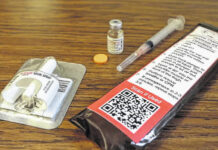Every three minutes, a woman in the U.S. is diagnosed with breast cancer.
That means in the time it takes me to write and submit this column, approximately 10 more women will be given this sobering diagnosis. I also heard on the radio this week that one out of every seven women will be affected by breast cancer either as a patient, caregiver, friend or co-worker of a woman with breast cancer.
I have a pretty tight knit group of “Besties.” When I counted us up last night we numbered seven, and guess what? One of us is a breast cancer survivor. I am happy to say that this particular friend is five years cancer free and doing fantastic. While we cannot do much about the hereditary component of developing breast cancer, the good news is that we can control lifestyle choices that may predispose us to developing this disease.
Exercise and a healthy diet are important components in breast cancer prevention and recovery. Two out of three of the top cancer types for both women and men can be positively impacted by exercise and diet. Research done on breast cancer has shown a correlation between fitness level, body composition and diet and the risk of developing the disease. Women with a high percent of body fat are more likely to develop breast cancer than women within the norms for their height and weight. This is the result of excess body fat causing an increased production of estrogen.
Once a woman has been treated for breast cancer an exercise program post treatment can help improve their quality of life. Fatigue, limited range of motion, and even fear of moving sore areas may make a woman shy away from exercise. The right kind of exercise, though, guided by trained professionals, can be of great benefit for women recovering from breast cancer.
Here are some benefits of exercising after a breast cancer diagnosis and treatment:
— Stress reduction/relaxation: One of the best things about exercise is that it can be relaxing and energizing at the same time. Women in recovery are often fighting stress and fatigue. Increasing energy levels and reducing stress are very important. Once cleared by the physician, yoga or Pilates is a great way to workout.
— Prevention of lymphedema: Lymphedema, or the accumulation of lymph fluids that can cause swelling, is a real complication of breast cancer. Slow gentle movements and light strength training can help keep the lymphatic fluid from pooling and causing issues. If lymphedema becomes an issue, there is a wonderful lymphedema therapy program at Southeastern Lifestyle Center for Rehabilitation.
— Improved motion: A woman recovering from breast cancer will be stiff, sore and protective of their chest area. Performing gentle active stretching and range of motion activities can improve movement and return them to normal daily activities sooner.
Before starting any exercise program after a breast cancer diagnosis, make sure you clear it with your surgeon and oncologist. Remember that breast cancer, when caught at an early stage, is treatable. Remember to do your self breast exams and get your mammogram when scheduled.







